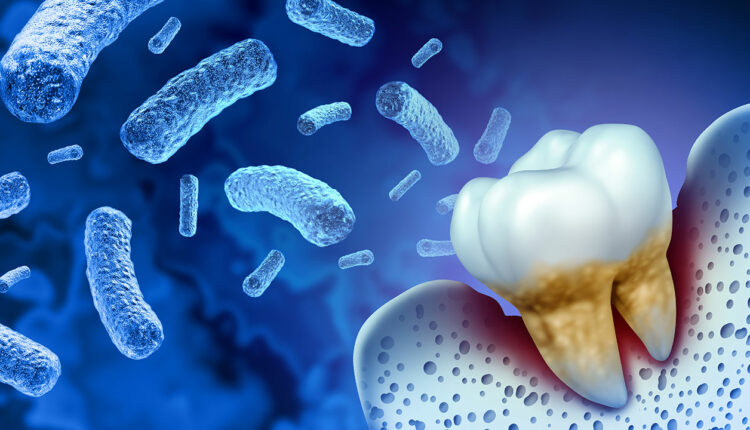 wildpixel / iStock / Getty Images Plus
wildpixel / iStock / Getty Images Plus
Role of Porphyromonas Gingivalis in Periodontal Diseases
This highly destructive oral pathogen leads to severe periodontitis.
Acknowledged as one of the most important bacteria in the etiology and pathogenesis of periodontal diseases, Porphyromonas gingivalis continues to be extensively studied, not only in periodontal diseases, but also in many systemic diseases based on its ability to infect distant tissues and organs.1–5 It is a highly destructive oral pathogen, and, together with Treponema denticola and Tannerella forsythia, it comprises the “red complex” bacteria associated with severe periodontitis.6
Although able to initiate periodontal diseases even at low levels in biofilm, P. gingivalis nevertheless requires the presence of other bacteria to cause disease.7 It also promotes the development of “pathobiont” species, or bacteria that become pathogenic in the presence of P. gingivalis. This Gram-negative anaerobe accomplishes this by altering the entire microbial community and triggering bacterial dysbiosis.8,9
The bacterium’s unique features offer new insights into the development and progression of periodontal diseases and the oral-systemic link.4,5,8,10,11 While the connection between oral and systemic health is not a new discovery, the process by which periodontal pathogens can invade and travel through barriers to the distant areas of the body has not been well understood and is being currently investigated.
P. gingivalis is the most studied oral bacterium due to its ease of growth under laboratory conditions and ability to be genetically manipulated.12 As P. gingivalis reaches the deeper areas of the sulcus/pocket where the environment is favorable for this secondary colonizer, it relies on other species to reduce oxygen concentration in the environment. Considered nonmotile, it has been shown to move under very specific environmental conditions, whether locally or to distant destinations, using what’s known as “gliding motility.”6,13
Found in more than 85% of biofilm samples from periodontal pockets in patients with chronic periodontitis,2 P. gingivalis almost exclusively resides in the three distinct microenvironments of the subgingival crevice: root surface, gingival crevicular fluid, and surface of the gingival epithelial cells lining the crevice. However, it is also present in the tonsillar area, tongue, and buccal mucosa in patients with and without periodontal diseases. It is asaccharolytic (does not rely on digesting sugars for energy production) but is able to ferment amino acids by breaking down the connective tissue proteins. P. gingivalis also requires iron for survival.
Like many other bacterial species, P. gingivalis gets iron from the hemoglobin of the red blood cells, overcoming the host strategies of reducing free iron during infection.14 It is the heme accumulation in the growing P. gingivalis colonies that gives them the unique dark purple-black color, which explains the bacterium’s name: Porphyromonas means “purple units” in Greek.2
Interestingly, P. gingivalis obtains iron using specific outer membrane receptors, proteases known as gingipains and lipoproteins. The bacterium is also capable of evading the host immune response without inflammatory response suppression. Actually, P. gingivalis and other pathogenic bacteria may take advantage of inflammation -deriving nutrients and iron from the inflammatory exudate.6 Twenty-two strains of P. gingivalis with varying degrees of invasiveness and virulence have been identified.15 The genome of one of its most virulent strains—W83—was sequenced in 2003, providing important information on the bacterium’s comparative genomics, metabolism, transport, and its virulence factors.1
References
- Nelson KE, Fleischmann RD, DeBoy RT, et al. Complete genome sequence of the oral pathogenic bacterium Porphyromonas gingivalis strain W83. J Bacteriol. 2003;185:5591–5601.
- How KY, Song KP, Chan KG. Porphyromonas gingivalis: an overview of periodontopathic pathogen below the gum line. Front Microbiol. 2016;7:53.
- Cutler CW, Kalmar JR, Genco CA. Pathogenic strategies of the oral anaerobe, Porphyromonas gingivalis. Trends Microbiol. 1995;3:45–51.
- Zhang Z, Liu D, Liu S, Zhang S, Pan Y. The role of Porphyromonas gingivalis outer membrane vesicles in periodontal disease and related systemic diseases. Front Cell Infect Microbiol. 2021;10.
- Viafara-García SM, Morantes SJ, Chacon-Quintero Y, Castillo DM, Lafaurie GI, Buitrago DM. Repeated Porphyromonas gingivalis W83 exposure leads to release pro-inflammatory cytokynes and angiotensin II in coronary artery endothelial cells. Sci Rep. 2019;9:19379.
- Mysak J, Podzimek S, Sommerova P, et al. Porphyromonas gingivalis: major periodontopathic pathogen overview. J Immunol Res. 2014;2014:e476068.
- Hajishengallis G, Liang S, Payne MA, et al. A low-abundance biofilm species orchestrates inflammatory periodontal disease through the commensal microbiota and the complement pathway. Cell Host Microbe. 2011;10:497–506.
- Hajishengallis G. Periodontitis: from microbial immune subversion to systemic inflammation. Nat Rev Immunol. 2015;15:30.
- Chopra A, Bhat SG, Sivaraman K. Porphyromonas gingivalis adopts intricate and unique molecular mechanisms to survive and persist within the host: a critical update. J Oral Microbiol. 2020;12:1801090.
- Hajishengallis G, Lamont RJ. Breaking bad: manipulation of the host response by Porphyromonas gingivalis. Eur J Immunol. 2014;44:328–338.
- Vermilyea DM, Ottenberg GK, Davey ME. Citrullination mediated by PPAD constrains biofilm formation in P. gingivalis strain 381. NpJ Biofilms Microbiomes. 2019;5:1–11.
- Chen T, Hosogi Y, Nishikawa K, et al. Comparative whole-genome analysis of virulent and avirulent strains of Porphyromonas gingivalis. J Bacteriol. 2004;186:5473–5479.
- Moradali MF, Ghods S, Angelini TE, Davey ME. Amino acids as wetting agents: surface translocation by Porphyromonas gingivalis. ISME J. 2019;13:1560–1574.
This information originally appeared in Marsh I, Matthews A. Porphyromonas gingivalis’ role in the pathogenesis of periodontal disease. Decisions in Dentistry. 2023;9(2):42-45.


